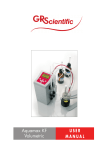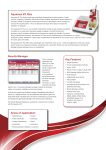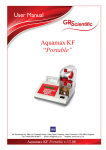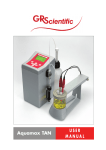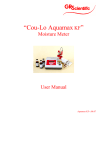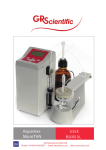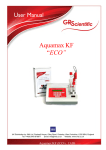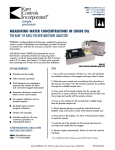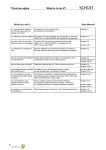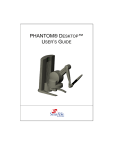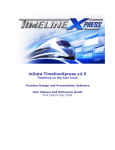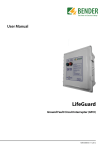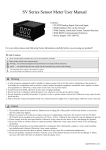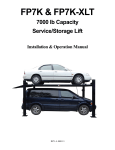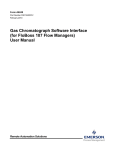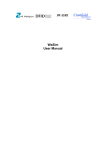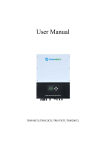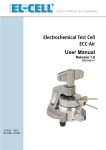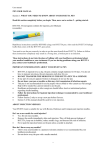Download AKF Oil Evaporator v1.1
Transcript
Aquamax KF Oil Evaporator User Manual Edition 1.1 - July 2015 Contents Chapter 1 Introduction .......................................................................... 2 1.1 Instrument Description ..................................................................... 2 1.2 Principle of Measurement ............................................................... 2 1.3 Instrument Connections ................................................................... 2 Chapter 2 Safety Information ................................................................. 3 2.1 General Safety Points ....................................................................... 3 2.2 Electrical Safety ................................................................................. 3 2.3 Tubing and Connections .................................................................. 3 2.4 Solvent and Chemical Safety .......................................................... 3 2.5 Recycling and Disposal ................................................................... 3 Chapter 3 Instrument Overview ............................................................. 4 3.1 System Schematic Overview ........................................................... 4 3.2 Front Panel ........................................................................................... 5 3.3 Rear Panel ............................................................................................ 5 Chapter 4 Instrument Setup ................................................................... 6 4.1 Receiving an Aquamax KF Oil Evaporator ................................. 6 4.1.1 Packaging .................................................................................. 6 4.1.2 Checks ........................................................................................ 6 4.1.3 Location ...................................................................................... 6 4.2 Connecting the Power Supply ......................................................... 6 4.3 Connecting to a Aquamax KF Coulometric ................................. 7 4.4 Programming the Aquamax KF Coulometric .............................. 7 Chapter 5 Basics of Operation ............................................................... 8 5.1 Switching ON/OFF .............................................................................. 8 5.2 How to Run a Test ............................................................................... 8 5.3 Setting the Gas Flow Rate ................................................................ 8 5.4 Setting the Evaporator Temperature ............................................. 8 5.5 Closing Down and Emptying the Vessel ...................................... 8 Chapter 6 Technical Specifications ........................................................ 9 Chapter 7 Parts and Accessories ............................................................ 9 Chapter 8 Conformity and Warranty .......................................................10 8.1 Declaration of Conformity ...............................................................10 8.2 Quality Control .....................................................................................10 8.3 Customer Support and Service ......................................................10 8.4 Warranty ...............................................................................................10 1 Chapter 1 Introduction 1.1 Instrument Description Key personnel at G.R. Scientific are recognised experts in Coulometric Karl Fischer titration technology and electrochemistry. They have designed and manufactured Coulometric titrators since the early 1980’s and are widely regarded as some of the leading specialists in this technique. The Aquamax KF Oil Evaporator model 510000 has been designed as a “stand-alone” unit so that it can be used in conjunction with most leading models of Coulometric and volumetric Karl Fischer titrators and to comply with the requirements of ASTM method D6304, “Standard test method for determination of water in petroleum products, lubricating oils and additives by Coulometric Karl Fischer titration”. 1.2 Principle of Measurement Karl Fischer titration is simply a means to measure water content of samples. Modern instruments, such as the Aquamax KF, use the Coulometric principle. This is an absolute technique which does not require calibration of the reagents. For further information, visit www.grscientific.com. It is important to know the water content of lubricating oils, additives and similar samples to enable accurate prediction of performance and quality. The presence of water in such samples could lead to corrosion and wear of machinery and reduce the effectiveness of the lubricating additives. If you are analysing an unknown sample then we suggest plotting a graph of water content against temperature as per following example. This will enable you to determine the best temperature range for a sample The two main parameters that you can change are gas flow rate and temperature. We suggest using carrier gas flow rate of 0.30 litre per minute (300 ml/min). Oven temperatures are usually set between 120 – 150°C. The maximum selectable temperature is 200°C and there is a thermal cut-out control above this temperature. For most lube oils we would suggest flow rate of 0.3 litres per minute and temperature of 140°C. 1.3 Instrument Connections Various ports are located on the back plate of the instrument. Below is a list of ports that can be found: (1) Power Supply Port The power supply port is for connecting to a 24V mains power supply, using the supplied power adaptor. (2) Thermocouple Port This port is for connecting the thermocouple. (3) Gas Out Port This port is for connecting the tubing to the desiccant bottle for when the gas is released through the tubing. (4) Gas In Port The gas in port is for connecting a carrier Gas supply. 2 ! ! Chapter Information ! !!!!!!!!B%C52D!@7C01&%2+07 !!!!!!!!2 Safety ! ! ! !!!!!!!!B%C52D!@7C01&%2+07 !!!!!!!! ! ! ! Safety ! ! 2.1! General Points ! !!!!!!!!B%C52D!@7C01&%2+07 !!!!!!!! ! ! ! ! !! ! ! ! ! ! ! ! ! ! ! ! ! ! !!!!!!!!B%C52D!@7C01&%2+07 !!!!!!!!GR !! products ! conformity with the EU Directives 2004/108/EC and Scientific are in ! ! ! ! ! ! ! ! ! ! ! !! ! ! !! ! ! ! ! ! ! ! !! ! !!!!!!!! ! ! !!!!!!!!B%C52D!@7C01&%2+07 ! 2006/95/EC. This is based upon the compliance of the products with the harmonised ! ! ! ! ! !! ! !! ! ! ! ! ! ! ! ! !! ! !! ! ! ! !EN standards: and BS ! ! ! ! BS !61000-4-2:2009; ! !! ! ! BS EN ! !61010-2-030:2010; ! !! ! ! ! !EN ! ! 61326-1:2013. ! ! ! ! ! ! ! ! ! ! ! ! ! ! ! ! ! ! ! ! !! ! ! ! ! ! ! ! ! ! ! ! ! Scientific products ! GR ! !! ! ! ! ! ! ! ! ! to RoHS ! ! ! ! ! ! !! ! are ! ! manufactured ! ! ! ! ! ! ! ! in! !accordance ! !! following ! !!! !! the EU Directive !! 2011/65/EU; the !restricted and ! ! substances ! !!in concentrations ! !! ! ! ! ! ! it!!does ! !! not !! ! ! contain !! ! ! ! any of ! ! ! ! ! !! ! ! ! ! !! ! !! ! ! ! ! ! by ! this! directive. ! !! ! ! ! ! banned ! applications ! ! ! ! ! ! ! ! ! ! ! ! ! ! ! ! ! ! ! !! ! ! ! ! ! ! !! ! ! ! !! ! ! ! ! ! ! ! ! !! !! ! ! ! ! !! ! ! ! ! ! !! ! !! ! ! ! !! ! ! ! ! ! 2.2 Electrical Safety ! ! ! ! ! !! !!! ! !! !! ! ! ! ! ! ! ! ! ! ! !! !! !!! ! ! ! ! ! ! ! !! ! ! ! ! ! ! !! !!! ! ! !! ! !! ! ! ! ! ! ! !! ! ! standard ! !IEC 61010. ! ! The! Aquamax ! ! ! !! KF Oil Evaporator complies with !the international ! ! ! ! ! ! ! ! ! ! ! ! ! ! ! ! ! ! ! ! ! Only ! ! ! instrument ! ! ! ! ! !! ! supply on the back ! !! ! operate ! ! !! this ! ! the ! ! ! voltage ! ! ! !! that ! ! ! ! ! !within ! ! mains ! is !specified ! of the instrument, an incorrect mains supply can damage the instrument. Never open the ! ! ! ! ! ! ! ! ! ! ! !! ! ! !! ! !! ! !! ! ! ! !! ! ! !! ! ! housing ! !only! GR! !! Scientific ! ! ! personnel ! !! !are! trained ! !! !!!!!!!!!!!!!!!!!!!!!!!!!!!!!!!!!!!!!!!!!!!!!!!!!!!!!!!!!!!!!!!!!!!!!!!!! ! ! ! !of!! !the ! ! ! ! ! !!instrument, !! ! ! ! ! who to service the ! ! ! ! ! ! ! ! ! ! ! ! ! ! ! ! ! ! !!! ! ! ! ! ! !! can ! ! ! ! ! ! A !! ! open ! ! ! ! ! ! ! ! ! ! instrument the housing. ! ! ! ! ! ! ! ! !!!!!!!!!!!!!!!!!!!!!!!!!!!!!!!!!!!!!!!!!!!!!!!!!!!!!!!!!!!!!!!!!!!!!! ! ! ! ! ! ! !! ! ! ! ! ! ! ! ! !! ! ! !! ! ! ! ! ! ! ! ! ! ! ! ! ! ! !! A! ! ! !! if ! ! ! ! There is! risk of! electrocution live components are touched. ! ! ! ! ! ! ! ! ! !! ! ! ! ! ! ! ! !! !!!!!!!!!!!!!!!!!!!!!!!!!!!!!!!!!!!!!!!!!!!!!!!!!!!!!!!!!!!!!!!!!!!!!!!!!! ! ! ! ! ! !! ! ! ! ! !! ! !! ! !! ! ! ! ! !A !! ! ! ! !! ! ! ! !! ! ! ! ! ! !! ! ! ! ! !! !! ! ! ! ! ! ! !! ! ! ! ! ! ! ! ! !or disconnecting ! ! !!!!!!!!!!!!!!!!!!!!!!!!!!!!!!!!!!!!!!!!!!!!!!!!!!!!!!!!!!!!!!!!!!!!!!!! Always ensure the instrument the! mains ! ! from ! ! when ! connecting ! is disconnected ! ! power supply ! ! ! ! ! ! ! ! ! ! ! ! ! ! ! ! ! ! ! ! ! ! ! ! ! ! ! !!!!!!!!!!!!!!!!!!!!!!!!!!!!!!!!!!!!!!!!!!!!!!!!!!!!!!!!!!!!!!!!!!!!!!!!!!!!!! cables the as! electrostatic discharge can !build up. ! ! ! ! ! ! from ! Aback ! ! of! the! instrument, ! ! ! ! ! ! !! !! ! ! ! ! A ! !! !! ! ! ! ! ! ! !! !! ! ! ! !! ! !! ! ! ! ! ! ! ! ! ! !! ! ! ! !! ! ! ! ! ! ! ! ! ! ! ! !! ! ! ! ! ! ! !! ! ! ! ! ! ! ! ! ! ! ! ! !! !! ! ! ! ! ! ! ! ! ! ! !! ! ! ! ! ! ! ! ! ! ! ! ! ! ! ! 2.3! Tubing and Connections ! ! ! ! ! ! ! ! !! ! ! ! ! ! ! ! !! ! ! ! ! ! ! ! ! !! ! ! ! ! ! !! ! ! ! ! ! ! ! ! !! ! ! ! ! ! ! ! ! ! ! !! in the tubing attention. Ensure all tubing is ! ! ! ! Leaks ! ! without ! ! are ! ! ! a! safety !! ! risk !!! ! if! left ! that ! ! !! ! !! ! ! ! !! !! ! ! ! !! screwed into the connections tightly by hand, without excessive force. Breaks in the ! !! ! ! ! ! ! ! ! ! !! ! ! ! !! ! !! ! ! ! !!! ! ! ! ! ! !! ! ! !tubing ! on the tubing can lead to spillages; check the ! ! !! !connections ! ! ! ! ! ! ! !! !connections ! ! ! ! ! ! ! ! !or ! ! ! ! ! ! ! ! ! ! ! !! ! !! ! !! ! ! ! ! ! ! ! !! ! ! ! ! ! ! ! regularly !!! ! !! ! to! ! !avoid !! ! !this. ! ! ! ! ! ! ! ! ! ! !! ! ! ! ! ! !! ! ! !!! ! ! ! !! ! !!! ! ! ! ! !! ! ! ! ! !! ! ! ! ! !! ! ! ! ! ! !! ! ! ! ! !! ! ! ! ! ! ! ! ! ! ! ! ! !! ! ! ! ! ! ! ! ! ! ! !! ! ! Solvent ! and ! Chemical 2.4 Safety ! ! ! ! ! ! ! ! ! ! ! ! ! ! ! ! ! ! ! ! !! ! ! ! ! ! ! ! ! ! ! ! ! ! ! ! ! ! ! ! ! ! ! ! ! ! ! ! ! ! ! ! ! ! ! ! ! ! ! ! ! ! ! ! ! ! ! ! ! ! ! safety ! ! ! ! or irritant ! ! solvents ! and! chemicals, ! ! follow suitable ! When using flammable measures to ! ! !! ! ! ! !! !! ! !! ! !! ! ! ! ! ! ! !! ! ! ! ! ! ! ! !! ! ! ! ! !around. ! ! the instrument in ! ventilated ! ! Always ! a well protect yourself and others use area, !!! ! !! !! ! ! ! ! ! ! ! ! ! ! ! ! !! ! ! ! ! ! ! ! ! ! ! ! ! ! ! ! clean up spilled fluids immediately, and keep flame sources away from the work area. ! ! ! ! ! ! ! ! ! !! ! ! ! !!! ! !! ! ! ! ! ! ! !! ! ! ! ! ! !! ! instructions of the! chemical manufacturer apply the correct !! !follow ! !the ! ! ! ! ! and !safety ! ! ! ! Always ! ! ! ! ! ! ! ! ! ! ! !! ! ! ! ! ! ! ! countermeasures that are required. ! ! ! ! ! ! ! ! ! !! ! ! ! ! ! ! ! !! ! ! ! !! ! ! ! !! ! ! ! ! !! ! ! ! !! ! ! ! ! !! ! ! ! ! ! !! ! ! ! ! ! ! ! !! ! !! ! ! Disposal ! ! ! !! ! ! Recycling ! ! and ! ! ! ! ! ! !! ! ! ! ! ! ! 2.5 ! ! !! ! ! ! ! ! ! ! !! !! ! ! ! ! !! ! ! instrument ! ! Electrical ! ! the ! ! ! (Waste !! ! ! Equipment) ! ! ! is !covered ! ! ! !by !! !WEEE ! ! !! Electronic ! !! !! and This ! ! ! ! ! ! ! ! ! ! ! ! ! ! !to prevent ! ! ! and harmful ! !effects ! ! on the Directive 2012/19/EU the! negative environment and ! ! ! ! ! ! ! ! ! ! ! ! ! ! public health. For more information on how to dispose of the instrument safely, please ! ! ! ! ! ! ! ! ! ! ! ! ! ! ! contact your local authority, your local waste disposal company or GR Scientific directly. ! ! ! ! ! ! ! ! ! ! ! 3 ! ! Chapter 3 Instrument Overview 3.1 System Schematic Overview 4 3.2 Front Panel 1 2 3 4 (1) Carrier Gas from Desiccant Bottle (2) Thermocouple (3) Temperature Meter (4) Gas Flow Meter 3.3 Rear Panel 1 4 2 5 3 6 7 (1) Thermocouple Port (5) Fuse (2) Gas Out Port (6) Power Input (3) Gas In Port (7) Bottle Clamp (4) I/O Switch 5 Chapter 4 Instrument Set Up 4.1 Receiving an Aquamax KF Oil Evaporator 4.1.1 Packaging The Aquamax KF Oil Evaporator is packaged in suitable protective packaging to ensure that no damage occurs during transit, only this packaging is suitable for the safe transportation during transit. Please keep this packaging as transit of the instrument may need to occur in the future. 4.1.2 Checks Once you have received the instrument, immediately check to make sure that there is no damage and no parts are missing. A delivery note will be included within the package to use to compare with the shipment. Ensure that inside the shipment has a calibration certificate for the instrument, if not please request this from the manufacturer. 4.1.3 Location The Aquamax KF Oil Evaporator has been developed for indoor use only. Locate the instrument within the work area where it is free from excessive: − vibrations − direct sunlight − ! contamination from chemicals ! !!!!!!!!B%C52D!@7C01&%2+07 !!!!!!!! ! ! − explosive environments − corrosive atmospheres ! temperature ! ! ! − major fluctuations ! ! ! ! ! ! ! ! ! ! ! ! ! ! ! ! ! ! 4.2 Connecting the Power !Supply ! ! ! ! ! ! ! ! ! ! ! The Aquamax KF Oil Evaporator is powered by an external mains source, with a power pack to ensure this ! connection is the correct voltage of 24V DC for the instrument. ! ! ! ! ! ! ! ! ! ! ! ! Damage may occur beyond !repair and the static! shocks if the ! !user !may! be suspect ! ! ! incorrect ! to! electric ! ! ! ! ! ! ! ! power is supplied. ! ! ! ! ! ! ! Note: Refer to Chapter 2 for ! ! ! more safety information. ! ! ! ! ! ! ! ! To avoid risk of electrocution, make ! ! ! ! ! ! ! sure the I/O switch is set to OFF before ! ! ! ! ! ! ! connecting the power supply. ! ! ! ! ! ! ! ! ! ! ! ! ! ! ! ! ! ! ! ! ! ! ! ! A ! ! ! ! ! ! ! ! ! ! ! ! ! ! ! ! ! ! ! ! ! ! !!!!!!!!!!!!!!!!!!!!!!!!!!!!!!!!!!!!!!!!!!!!!!!!!!!!!!!!!!!!!!!!!!!!!! ! ! ! ! ! ! ! ! ! ! ! ! ! ! ! ! ! ! ! ! ! ! ! ! ! ! ! ! ! ! ! ! ! ! ! ! ! ! ! ! ! ! ! ! ! ! ! ! ! ! ! ! ! ! ! ! ! ! ! ! ! ! ! ! ! ! ! ! ! ! ! ! ! ! ! ! ! ! ! ! ! ! ! ! ! ! ! ! ! ! ! ! ! ! ! ! ! ! ! ! ! ! 6 ! ! ! ! ! ! ! ! ! ! ! ! ! ! ! ! ! ! ! ! ! ! ! ! ! ! ! ! ! ! ! ! ! ! ! ! ! ! ! ! ! ! ! ! ! ! ! ! ! 4.3 Connecting to an Aquamax KF Coulometric (1) Fit gas inlet nipple to rear of evaporator. (2) Locate small “O” rings and injection septa inside holes of vessel lid and screw in compression fittings. Do not over-tighten as other items will need to be fitted. (3) Connect long length tubing to gas distribution tube, feed through correct compression fitting and connect to desiccant bottle outlet fitting. Gas distribution tube should be located at bottom of vessel to allow optimum bubbling of carrier gas through the base oil and samples. Apply smear of silicone grease to large“O” ring of lid assembly before locating onto evaporator glass vessel. Tighten compression fitting. (4) Position thermocouple in vessel lid and tighten compression fitting. Connect cable to rear panel of evaporator. Position thermocouple so that it is half way between bottom of vessel and the line indicating base oil depth. Do not locate so that it is touching bottom of vessel. (5) Connect short length tubing to the inside of desiccant bottle lid. This should be from carrier gas supply cylinder so that gas flows through maximum amount of desiccant. Fill desiccant bottle with molecular sieve. Locate filled desiccant bottle on rear of evaporator unit. Outlet of desiccant bottle should be connected to the gas distribution tube. (6) Using a funnel, measuring cylinder or suitable volume syringe, add 10ml base oil to evaporator vessel. (7) Connect gas sample inlet and outlet adapters to Aquamax KF titration vessel. (8) Charge the titration vessel with 150ml anode and 10ml cathode reagents and allow to precondition as per titrator user manual instructions. These larger volumes of reagents allow greater depth of reagent for the carrier gas to bubble through. (9) Connect the outlet from vessel of oil evaporator to gas inlet adapter of titration vessel using short length tubing and elbow connector. This distance between evaporator and titrator should be kept to minimum to reduce any problems of condensation in transfer tubing. (10) Set oven temperature. (11) Turn three way cock of gas inlet adapter so that gas flow is directed away from titration vessel out of the side arm. This allows drying of all carrier gas lines up to the connection with titrator. (12) Set gas flow rate. (13) Vent the outlet adapter from titration vessel to fume hood or outdoors using some plastic tubing or similar. (14) After the gas lines have been sufficiently dried, divert the gas flow, using the three way cock, so that it bubbles through the titration vessel. The background drift value of the titrator will increase whilst the gas lines are dried; this process may take 30 – 90 minutes depending on how dry the carrier gas supply is. (15) When background drift is relatively stable, and preferably below 20 microgram per minute, the unit is ready for sample analysis. 4.4 Programming the Aquamax KF Coulometric Note: Refer to the Aquamax KF Coulometer user manual. Programme the titrator to provide results in ppm or % as required, and select calculation mode W/K. Result (ppm or %) = microgram count - bl W Where: xK W = weight of sample dissolved (approx. 5.0 g) K = total volume of diluent + sample volume injected into Aquamax bl = micrograms of water for 1.0ml of diluent (μg) (10.0ml) K = 10 (1.0ml) To allow time for the injected sample to be heated, the water liberated and carried through to the titration vessel by the gas stream, it is advisable to programme a Start Delay of, for example, 1.0 minute. It can also be helpful to programme a Minimum Titration Time of, for example, 2.0 minutes. To conform to ASTM D6304 add 5 ± 0.01g of accurately weighed sample in a 10ml volumetric flask. Make up to volume with dried hexane. Shake the sample until it is completely dissolved in the solvent. Inject 1ml of dissolved sample into the evaporator vessel and start the titrator. 7 ! ! !!!!!!!!B%C52D!@7C01&%2+07 !!!!!!!! ! ! ! ! ! ! ! ! ! ! ! ! ! ! ! ! ! ! ! ! ! ! ! ! ! ! ! ! ! ! Chapter 5 Basics of Operation ! ! ! ! ! ! ! ! ! ! ! ! ! ! ! ! 5.1 Switching ON and OFF ! ! ! ! ! ! ! ! ! ! ! ! ! ! ! ! ! ! ! ! ! The Aquamax KF Oil Evaporator has one I/O switch and is powered by either a mains power supply using an ! ! ! ! ! ! ! adaptor, or a built-in battery for power. ! ! ! ! Note: Refer to Chapter 4.2 for power supply connections. ! ! ! ! ! ! ! ! ! ! To avoid risk of electrocution, make sure the ! ! ! ! ! ! ! ! I/O switch is set to OFF before connecting the ! power ! supply ! from a mains ! source. ! ! ! ! ! ! ! ! ! ! ! ! ! ! ! ! ! ! ! ! ! ! ! ! ! ! ! ! ! A ! ! ! ! ! ! ! ! ! ! ! ! ! ! ! ! ! ! ! !!!!!!!!!!!!!!!!!!!!!!!!!!!!!!!!!!!!!!!!!!!!!!!!!!!!!!!!!!!!!!!!!!!!!! 5.2 How to Run a Test ! ! ! ! ! ! ! ! ! ! ! ! ! ! ! The Aquamax KF supply using an ! ! has ! ! one! I/O switch! and ! is powered ! by either ! power ! ! Oil !Evaporator ! a! mains adaptor, or a built-in battery for power. ! ! ! ! ! (1) Confirm that Aquamax KF is in “Ready” mode and background drift is stable. ! ! !times with ! !dissolved ! ! sample. ! ! ! ! ! (2) Flush 1.0ml syringe several ! ! ! ! ! ! ! ! ! ! (3) Fit luer needle and flush through with sample. ! ! ! ! ! ! ! ! ! ! ! ! (4) Draw dissolved sample for analysis into! syringe the 1.0ml marking. ! ! ! beyond ! ! ! ! ! ! ! ! ! ! (5) Invert syringe so that any air bubbles can be ejected through the needle and adjust syringe plunger to ! ! ! ! ! the 1.0 ml mark. ! ! ! ! ! ! ! ! ! ! ! (6) Wipe off excess sample from outside of needle using a clean, dry tissue or paper towel. ! ! ! ! ! ! ! ! ! ! ! ! ! (7) Press titrator [START]. ! ! ! ! ! ! ! ! ! ! ! ! ! septa ! !of oil! evaporator ! ! ! ! ! ! ! ! (8) Pierce needle through injection vessel. ! ! ! ! ! ! ! ! ! (9) Inject dissolved sample into the base oil. ! (10) Withdraw syringe from evaporator vessel. ! ! ! ! ! ! ! ! ! ! ! ! ! ! ! ! can !be adjusted ! ! flow ! rate. ! applications ! ! to change ! The gas flow meter has !a needle valve which the !gas Most 5.3 Setting the Gas Flow Rate ! ! ! ! ! ! ! ! ! ! ! ! should be run at 300 ml / minute. (1) Set the display to 0.30. (2) Turn gas valve clock wise to decrease and anti-clock wise to increase gas flow. (3) Use the locking ring to lock into place. ! ! 5.4 Setting the Evaporator Temperature (1) Press [Set]. The display shows St 1 and then shows selected temperature. (2) To change set temperature press arrows until desired temperature is shown then press [Set] to confirm new value. (3) The display will then return to standard view. 5.5 Closing Down and Emptying the Vessel The evaporator vessel can be used for up to 20 sample analyses before it is necessary to empty. When samples have been completed simply switch the evaporator to OFF and turn off the dry gas supply. Disconnect the titration vessel gas inlet adaptor from the oil evaporator. Allow the evaporator vessel to cool sufficiently before using a suitable size syringe or similar device to withdraw the base oil and sample mixture from the vessel. Do not switch on the heater until the base oil has been replaced. 8 ! Chapter 6 Technical Specifications Model: 510000 Heater Type: Silicon Mat Heater Temperature Range: Ambient to 200°C Temperature Control: Digital Setting Gas Flow Rate: 300ml / Minute Gas Flow Control: Digital Setting Carrier Gas: Nitrogen Gas (Not Supplied) Desiccant: Molecular Siev Power Supply: 24v DC 100 – 240v AC 50 – 60 Hz Dimensions: 180 x 240 x 210 mm Weight: 3kg Chapter 7 Parts and Accessories Part No. Product 510000 Aquamax KF Oil Evaporator All of the below is supplied with the instrument but are also available as spare items. 401528 Power Adaptor 503086 Glass Vessel 503087 Vessel Lid 503088 Red Compression Fitting (4pk) 503089 Injection Septa (20pk) 503091 Vessel Gas Distribution Tube 503092 Pack 1 Large & 3 Small “O” Ring 503093 Gas Inlet Tube with 3-way Cock 503094 Gas Outlet Tube 503095 Desiccant Bottle 503096 Bottle Molecular Sieve 503097 Thermocouple K Type 503098 Plastic Tubes (4pk) 503099 Base Oil, 1 litre 503100 Silicone Grease (tube) 9 Chapter 8 Conformity and Warranty 8.1 Declaration of Conformity GR Scientific products are in conformity with the EU Directives: • 2004/108/EC Electromagnetic Compatibility Directive • 2006/95/EC Low Voltage Directive This is based upon the compliance of the products with the harmonised standards: • BS EN 61000-4-2:2009 Electromagnetic Compatibility. Generic immunity standard. Residential, commercial and light industry; • BS EN 61010-2-030:2010 Safety requirements for electrical equipment for measurement, control and laboratory use. Particular requirements for testing and measuring circuits; • BS EN 61326-1:2013 Electrical equipment for measurement, control and laboratory use. EMC requirements. General requirements. 8.2 Quality Control The Aquamax KF Coulometric; is adequately and professionally Quality Controlled to ensure that it is fully functional and to ensure that it meets all of the requirements that the instrument supports. 8.3 Customer Support and Service We want you to maximise the return on your equipment through a service program tailored to your requirements from when you purchase our equipment which includes: • Support and Repair • Maintenance and Calibration • Training and Installation • Quality Assurance and Certification Our dedicated service staff are on hand to help in the unlikely event that your equipment develops a fault. Please contact us using the details provided to discuss the next step. 8.4 Warranty Under the conditions of our warranty, all faults which are proved to be due to material, construction or manufacturing defects, which occur within 24 months of the delivery date, will be repaired or replaced, (at our discretion), free of charge at our premises. Freight costs will be chargeable along with any inspection work which was not necessitated by manufacturing or material defects. Breakages of glassware or electrodes are not covered by this guarantee. In the event of instrument failure during the warranty period, written authorisation must be obtained from the manufacturer prior to shipping. 10 GR Scientific Building 69, Wrest Park Silsoe, Bedfordshire, UK, MK45 4HS tel: +44 (0) 1525 404747 fax: +44 (0) 1525 404848 [email protected] www.grscientific.com














